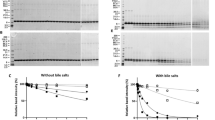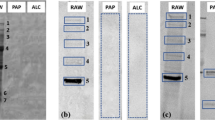Abstract
Stability under digestion is thought to be an important prerequisite determining the allergenicity of food proteins. To test this hypothesis, two important allergenic plant-derived foods were selected for this investigation. Protein extracts from roasted peanuts and unprocessed (native) hazelnuts were digested by a static, two-step in vitro procedure with commercial enzyme tablets containing peptic and pancreatic enzymes, respectively. The food extracts were subjected to gastric digestion for 2 h followed by a 45-min treatment under duodenal conditions. Undigested control samples and the two digests were investigated by analytical sodium dodecyl sulphate-polyacrylamide gel electrophoresis (SDS-PAGE), by SDS-PAGE immunoblotting, by an enzyme allergosorbent test (EAST) with human IgE, and by a rat basophil leukaemia (RBL) cell mediator release assay that depends on specific IgE raised in mice. Peanut proteins appeared to be more stable under digestion than hazelnut proteins, as shown by electrophoresis. These results were also underlined by immunblot data. The gastric digest from peanut contained various protein fragments that were detected by antibodies from a peanut-specific rabbit antiserum and by IgE from patients allergic to peanuts. These immunoblot reactivities decreased strongly after subsequent pancreatic digestion. In the gastric digest from hazelnuts, a rabbit antiserum with a broad reactivity against native hazelnut proteins exclusively recognized small protein fragments of <15 kDa. This serum showed no binding to blots of the pancreatic digest. Sera from hazelnut-allergic patients presented IgE reactivities to an 18-kDa major allergen with homology to major tree-pollen allergens, to a minor allergen of 12 kDa, and to multiple bands 1 30 kDa in native hazelnut extract. No binding was observed with these sera on blot strips of the two digests prepared from hazelnut extract. Under the native conditions of EAST, both digests from peanuts strongly reacted with human IgE. Their IgE binding capacity persisted at a level of about 50% when compared to undigested peanut. In the case of hazelnuts the IgE reactivity of the untreated samples was reduced to <10% by both gastric and combined gastric/duodenal digestion for a serum pool prepared from four patients and sera from three additional participants. By contrast, a constantly high immunoreactivity of the hazelnut digests was detected with serum from one patient. The results of the EAST were confirmed by dose-related mediator release experiments performed with RBL cells passively sensitized with allergen-specific murine IgE. As a whole, our results indicated that the EAST and the RBL cell assay are superior to immunoblotting for the immunologic testing of digests. In accordance with clinical observations, the allergenicity of peanut proteins was very persistent during digestion, whereas the native birch-pollen-related hazelnut allergens appeared to be relatively labile under identical conditions.
Similar content being viewed by others
Author information
Authors and Affiliations
Additional information
Received: 6 July 1998
Rights and permissions
About this article
Cite this article
Vieths, S., Reindl, J., Müller, U. et al. Digestibility of peanut and hazelnut allergens investigated by a simple in vitro procedure. Eur Food Res Technol 209, 379–388 (1999). https://doi.org/10.1007/s002170050513
Issue Date:
DOI: https://doi.org/10.1007/s002170050513




